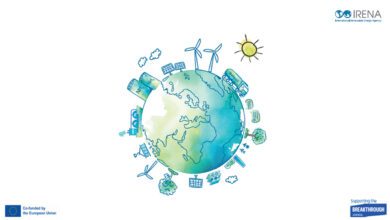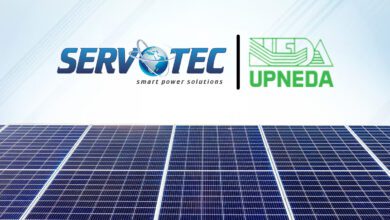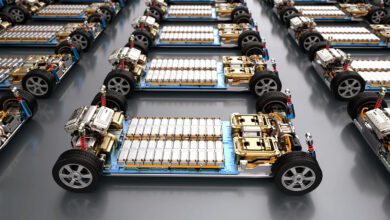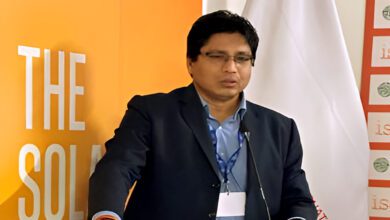Strategic Elements Ltd (SOR) has achieved another significant milestone with its self-charging battery technology successfully generating an output of over 4V from moisture in the air over a testing period of approx 5 hours. This was achieved through development of a prototype battery pack containing multiple connected battery ink cells. The self-charging battery ink technology is being designed to generate electricity from humidity in the air or skin surface. It is being developed under a collaboration partially funded by a Federal Government grant with CSIRO and the University of New South Wales.
The technology is demonstrating strong early stage potential by recently scaling up to 1 litre ink batch size and now rapidly increasing from 0.8V in a single cell to a maximum voltage of 4.4V from the first prototype battery pack developed. Further development on a) reducing battery ink cell size whilst retaining the same voltage output and b) developing battery ink cells capable of being fabricated onto a flexible textile material has commenced. The self-charging battery technology has strong potential competitive advantages over traditional batteries and power sources that suffer from flexibility, dimension, weight and/or safety issues whilst needing a constant power supply or to be charged.
Milestone Achieved with over 4V from Prototype Battery Pack
Five battery ink cells each 1cm x 1cm in area weighing less than a few milligrams and thinner than a human hair were fabricated onto glass. The cells were successfully serially connected to each other and placed in a testing chamber with 75% humidity (human skin is known to generate elevated levels of humidity to 90%). The battery pack successfully sustained an open circuit voltage output in excess of 4V over a 5 hour testing period with a maximum of 4.4V achieved. The humidity level was reduced to approx. 55% over the testing period with the voltage output remaining above 4V. The voltage output showed no sign of degradation over the testing period.
The ability of the technology to self-charge by harvesting energy from humidity in the air was demonstrated by manipulating moisture in the testing chamber. After reducing the humidity to less than 1% (a desert has humidity of approx. 20%) the voltage as expected reduced to 0.17V. As humidity was re-introduced the battery pack returned to producing its peak voltage. A patent application was lodged 27/01/21 over aspects of the work conducted under the program. Further work will be conducted to test the battery ink cells with different loads and levels of humidity.
Development Milestone – Reducing Battery Ink Cell Size
Early observations suggest battery ink cells have potential to be reduced in size whilst still generating a similar level of voltage (0.8V). Significantly, this could potentially enable development of much smaller devices or greater energy generated from a specific area. The next development milestone is to develop battery ink cells up to four times smaller than the existing cells. For illustration, this would enable four cells to be fabricated in the space taken by one current cell (1cm x 1cm). Voltage output will be tested over a five hour period to determine whether a similar level of voltage (0.8V) can be generated from the smaller cells. Potential of reducing cell size further will be investigated if the programme is successful.
Further Development
The technology is being designed to be a hybrid electric generator – battery cell fabricated with a printable ink. Development to date has been focused on voltage and the ability to harvest energy from humidity in the air. The initial market focus remains on wearables and IoT related devices as they have lower energy output requirements such as cosmetic, pressure, environmental and health (e.g. diabetes or cardiovascular monitoring). Higher performance applications will require development of a capacitor for energy storage and regulation and will be focused on at a later date.
Skin patches are wearable products that have integrated electronic components such as sensors that are attached to the surface of the skin. The higher humidity levels of the human skin make the electronic skin patch sector a natural fit to test the technology for real world applications. The sector produced USD 10 billion in revenue in 2019 and is forecast to grow to nearly USD 40 billion by 2030. A further development milestone is to develop Battery Ink cells capable of being fabricated onto a flexible textile material. The mechanical capability of the cells to be flexed will then be tested. The Company has an initial goal of achieving 500 bending cycles.
Environmental Technology Aspects
Harvesting green energy from the environment plays a vital role in the development of future energy supply. Moisture, one of the most abundant green energy sources, remains to be utilized for energy harvesting and conversion from thermal energy to electricity. In addition, the materials used in the battery ink technology are potentially environmentally friendly unlike those used in traditional batteries.
Managing Director Charles Murphy said “We are obviously very encouraged with the milestones being achieved by UNSW and the team. In response to that we are adding in PhD material science expertise and developing a panel of industry specialists. The technology sits across two of the strongest 2021 investment sectors in batteries and environmental technologies and is a very good fit for our high-risk, high reward Pooled Development Fund structure”.
UNSW Professor Dewei Chu said “My group at UNSW have developed deep experience in printed electronic inks, energy harvesting and storage over the past 9 years. Although still under development the battery ink is developing promisingly as an electrical generator battery technology. Our strong collaboration with the Strategic Elements team is enabling us to move forward expeditiously”.













